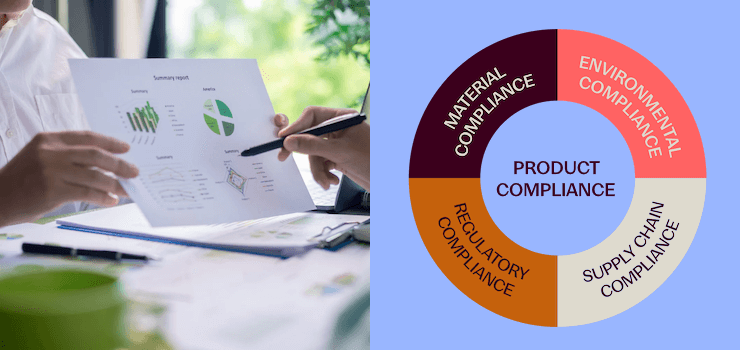TSCA compliance is gaining urgency. With rising enforcement and evolving reporting requirements, the Toxic Substances Control Act is reshaping how companies manage chemical substances in the U.S. market. Following the Lautenberg Chemical Safety Act, regulators now expect clear documentation, proactive risk management, and full supply chain transparency – especially around PFAS and other substances that may present an unreasonable risk.
This article outlines who’s affected, what the key rules are, and how companies can meet TSCA requirements efficiently and reliably.
Table of Contents
- Toxic Substances Control Act (TSCA): Key Facts at a Glance
- What the Toxic Substances Control Act (TSCA) Regulates – And Why It Matters
- Who’s Affected by TSCA Regulations?
- TSCA Sections Explained: Core Provisions to Know
- TSCA Lists: Inventory, Restrictions, and What They Mean for Businesses
- What Happens If You Don’t Comply? TSCA Enforcement in Practice
- How IPOINT Helps You Stay Compliant
What the Toxic Substances Control Act (TSCA) Regulates – And Why It Matters
Originally passed in 1976, the Toxic Substances Control Act (TSCA) gives the U.S. Environmental Protection Agency (EPA) broad authority to evaluate, regulate, and control chemical substances in U.S. commerce. It applies to any chemical that is manufactured, imported, processed, distributed, or used in the United States — whether as a raw material, intermediate, or within finished products and articles.
The law was fundamentally updated in 2016 through the Lautenberg Chemical Safety Act. Since then, TSCA regulations have become more targeted and risk-based. Substances that may pose an unreasonable risk to human health or the environment are now subject to closer scrutiny, including restrictions or even bans.
This includes not only high-profile substances like asbestos or persistent, bioaccumulative, and toxic (PBT) chemicals — but also historically significant chemicals such as polychlorinated biphenyls (PCBs), which were one of the original targets when it was enacted to control their widespread environmental and health impacts. Over time, TSCA’s scope expanded to address additional hazardous substances including radon, lead-based paints, and mercury.
Today, the law also covers more complex and emerging chemical groups such as PFAS (per- and polyfluoroalkyl substances), which are subject to extensive PFAS TSCA reporting and data submission requirements under Section 8(a)(7).
Who’s Affected by TSCA Regulations?
TSCA applies broadly across industries and company sizes. If a product contains regulated chemicals and enters the U.S. market, the law is relevant – whether it’s manufactured domestically or imported from abroad.
Even businesses that don’t produce chemicals themselves can be impacted. Distributors, processors, and article manufacturers must ensure their products don’t include substances on the TSCA restricted substances list without proper notice or authorization.
For companies sourcing globally, this means knowing exactly what’s in the materials they buy – and verifying that those substances are listed on the TSCA Inventory or substance list, classified as active, and compliant with applicable rules.
Ensure Compliance from Day One

Know your obligations, validate your supply chain, and prepare for U.S. market access – all with one scalable solution for TSCA compliance.
TSCA Sections Explained: Core Provisions to Know
While TSCA regulations span many technical areas, three sections are particularly relevant for manufacturers, importers, and compliance teams: Section 5, Section 6, and Section 8. Together, they define how the EPA approves new substances, evaluates chemical risks, enforces restrictions, and collects essential data from companies dealing with chemical substances in U.S. commerce.
Section 5 – Premanufacture Notices (PMN) for New Substances
Section 5 requires companies to notify the EPA before manufacturing or importing a new chemical not listed on the TSCA Inventory. This is done via a Premanufacture Notice (PMN) or a Significant New Use Notice (SNUN) if an existing substance will be used differently.
The EPA reviews submitted data to assess potential risks to human health and the environment and may impose restrictions, testing, or recordkeeping obligations before market entry — preventing hazardous substances from entering U.S. commerce without evaluation.
Section 6(h) – Restrictions, Risk Evaluation, and Control
Section 6(h) allows the EPA to restrict, phase out, or ban substances that pose an unreasonable risk, regardless of production volume. Once listed under Section 6(h), companies must follow strict use conditions or discontinue use entirely.
Examples of regulated or prioritized substances include:
- Asbestos – strict use limitations due to severe health risks
- PCBs – one of TSCA’s original targets, now heavily restricted
- Lead-based paints – banned in most uses due to risks to public health and children
- Mercury and mercury compounds – controlled for neurotoxic and environmental risks
- PBTs – prioritized for rapid risk management
- DecaBDE and phenol, isopropylated phosphate (3:1) – restricted flame retardants
The EPA continually reviews existing substances to adapt restrictions to new scientific knowledge and industrial practices.
Section 8(a)(7) – Reporting and Recordkeeping
Section 8(a)(7) covers various reporting obligations, including the collection of exposure and use data. A key update is the rule requiring PFAS disclosures from manufacturers and importers – even if those substances are present in low concentrations.
Under Section 8(a)(7), companies may be required to:
- Submit production volumes and use data
- Disclose processing and distribution details
- Maintain records for audits and inspections
Failure to comply may trigger TSCA enforcement actions, especially in cross-border shipments or cases involving unlisted or inactive substances.
TSCA Lists: Inventory, Restrictions, and What They Mean for Businesses
To legally manufacture or import a chemical in the U.S., the substance must be listed on the TSCA Chemical Substance Inventory. This is the official reference point for determining whether a substance is “existing” and eligible for use under TSCA. The Inventory currently contains more than 86,000 substances, of which roughly 40,000 are classified as active.
The inventory distinguishes between:
- Active substances: Cleared for ongoing commercial use
- Inactive substances: Must be re-notified before reintroduction
Common TSCA list terms and what they actually mean:
- TSCA substance list / TSCA chemical list: Often used interchangeably to refer to the overall inventory – includes active and inactive entries.
- TSCA restricted substances list: Not a formal EPA document, but commonly refers to substances regulated under Section 6 rules.
- TSCA 6(h) list: Specific subset of chemicals restricted for presenting high risk – often includes PBTs.
Companies must ensure every input material is either:
- On the active list,
- Exempted under specific use rules (e.g., research and development or certain article exemptions), or
- Under review via Premanufacture Notice (PMN) if newly developed.
Importers must also certify to U.S. Customs that their shipments comply with TSCA requirements before entry into the country.
Misclassifying a substance or using it without approval can trigger penalties, shipment delays, import holds, or enforcement actions – even if the product contains it in small quantities.

What Happens If You Don’t Comply? TSCA Enforcement in Practice
As outlined earlier, TSCA grants the U.S. Environmental Protection Agency (EPA) broad authority to regulate chemical substances in commerce. That authority doesn’t stop at guidance – it comes with real enforcement power.
Violations can trigger serious consequences. Civil penalties can exceed USD 40,000 per day, per violation. Depending on the case, the EPA may also order corrective actions, product recalls, or block shipments at the border.
Typical compliance failures include:
- Importing or processing unlisted TSCA substances
- Using inactive substances without prior notification
- Missing reporting deadlines or submitting incomplete data
- Ignoring restrictions on PBTs, PFAS, or other regulated TSCA chemicals
In recent years, enforcement has intensified – particularly for PFAS Compliance disclosures, substances subject to TSCA restrictions, and products entering the U.S. without clear substance traceability.
For globally operating companies, this means that chemical compliance is not just a documentation task – it’s a regulatory risk factor that requires proactive management and cross-border coordination.
How IPOINT Helps You Stay Compliant
TSCA compliance requires more than isolated spreadsheets or manual tracking. Companies need structured processes to manage chemical data, monitor regulatory changes, and generate audit-ready documentation.
IPOINT’s Environmental Compliance Software provide the digital backbone for this work – supporting every stage from substance screening to reporting.
Key benefits:
- Centralized substance and supplier data:
ensuring full visibility across your supply chain - Automated documentation workflows:
to meet TSCA reporting requirements, including Section 6 & 8 - Integrated risk management tools:
to flag TSCA restrictions and keep track of regulated substances - Scalable architecture:
adaptable to other frameworks like REACH, RoHS, or the EU Battery Regulation
For companies looking to future-proof their compliance strategy, IPOINT provides a single source of truth — the central platform for reporting, documentation, and substance management under TSCA.
Frequently Asked Questions
What are the penalties for non-compliance with TSCA?
Does TSCA apply to imported products or components?
Yes. Any chemical substance or article containing regulated substances that enters U.S. commerce falls under TSCA – regardless of origin.
What is the TSCA Inventory – and why does it matter?
It’s the official list of chemical substances allowed in the U.S. market. Only active substances can be manufactured or imported without prior EPA approval.
What is TSCA Section 6 – and what does it require from companies?
TSCA Section 6 governs the evaluation and regulation of chemical substances that present an unreasonable risk to human health or the environment. The EPA can impose restrictions, phaseouts, or bans—regardless of production volume. Companies must ensure they comply with any Section 6 rules and verify that their products and supply chains do not contain prohibited or restricted substances.
What is TSCA Section 8 – and what are companies required to report?
Section 8 covers reporting and recordkeeping. Companies must submit data on substance use, exposure, and volume – including recent PFAS-related disclosures.

.png?width=740&name=tsca-ipoint(1).png)





